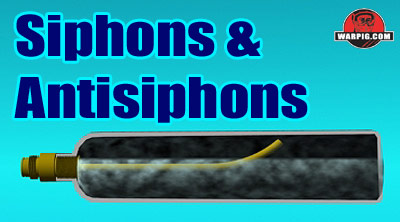  |
|
|
|
|
|
|
  |
|
|
|
|
|
|

What
do you think?
|

Siphons and Anti-Siphons Dealing With Liquid CO2 By Bill Mills - March 2006 Ever since Lou “Gramps” Grubb and Mike “Grizzly” Grubb started putting refillable carbon dioxide tanks on paintguns in the early 1980s, paintball players have had to face liquid CO2. CO2 exists in three states – gas liquid and solid. CO2 has a very unusual quality. At atmospheric pressures its boiling point is lower than its freezing point. This gives rise to the name “dry ice” for solid CO2. Dry ice doesn’t melt into liquid, it sublimates straight to gas. Under pressure however, CO2 can be condensed into liquid form, and this is what makes it desireable as a paintball propellant. A filled paintball tank has both liquid and gaseous CO2 in it. Just like a half full bottle of soda, the liquid CO2 is held in the bottom of the tank by the inescapeable force of gravity.
This is where the liquid CO2 kicks in. As soon as the pressure of the gas in the tank drops below the vapor pressure for CO2 at its given temperature, the CO2 will boil converting into gas. It is a mistake to think that boiling of CO2, water, or any other liquid requires high temperatures. The boiling point of a liquid is affected by temperature and pressure. Even at cold temperatures, liquid CO2 will boil into gas as soon as the pressure around it gets low enough. As the boiling liquid CO2 converts to gas, the pressure level in the CO2 tank is restored, acting as an automatic method of pressure regulation. There are a host of other issues related to temperature and this phase change, but for now as we are focusing simply on liquid CO2 we’ll bypass them before this article becomes an intensive physical chemistry lesson. Liquid CO2 can be troublesome for paintguns, especially those designed for low-pressure operation, or with low pressure pneumatics. If the liquid CO2 into a paintgun’s valve, it can cause a sharp spike in velocity as it expands into gas while propelling the paintball. In an even worse scenario, some paintguns with low-pressure pneumatics hoses or components can be damaged if liquid CO2 gets past their regulator and expands into gas there, raising pressure beyond what the components can handle. Fortunately, liquid CO2 is much easier to control than most paintball players realize. Visualizing the model of a partially full soda bottle can help understand what is going on in the CO2 tank. If the soda bottle is held vertically and squeezed, only the air and CO2 from the soda carbonation will blow out of the top. On the other hand, if it is tipped on its side, it is the soda that will come squirting out.
Much of paintball however, is driven by style, and by the mid 1990s, the popular style was a bottom-line arrangement, where the CO2 tank screwed horizontally into an ASA on the bottom of the paintgun’s grip frame. Angled bottom lines performed similar to angled back-bottles, but most were horizontal, leading to intermittent feeding of liquid or gas as the liquid CO2 sloshed around in the tank.
The other approach, the anti-siphon installs inside the CO2 tank. An anti-siphon tube is a short J shaped tube that reaches from the tank’s valve inside the tank and is bent to a position such that its end will be next to the top edge of the tank when the tank is screwed into a bottom-line. In operation, the anti-siphon is a lot like a skin-diver’s snorkel, allowing the paintgun to take a breath of CO2 from above the liquid even when the valve is below the level of the liquid.
While both remotes and anti-siphon tanks are effective ways to protect a paintgun from liquid CO2, the two systems don’t work well together. Here’s why – if an anti-siphon equipped CO2 tank is placed vertically in a pack for use with a remote or in a vertical ASA, it will end up acting as a siphon, drawing liquid CO2 out of the tank like a soda straw.
When an airsmith installs an anti-siphon tube in a tank, the valve is usually marked with an etched line or X. When the tank is screwed into the bottom-line it should be positioned with the mark facing up, otherwise if rotated to a position where the anti-siphon is pointing downward, it will act as a siphon.
The siphon used in paintgun tanks is flexible and weighted so that whether the tank is vertical, horizontal, or somewhere in-between, liquid CO2 will get to the paintgun. But with all these steps to prevent liquid, why would someone want it in purpose? A number of paintguns were designed to operate on liquid, including some early Tippmann models and the Mega-Z from Montneel. With valves designed for liquid CO2, velocity spikes were not a problem.
|
| Copyright © 1992-2019
Corinthian Media Services. WARPIG's webmasters can be reached through our feedback form. All articles and images are copyrighted and may not be redistributed without the written permission of their original creators and Corinthian Media Services. The WARPIG paintball page is a collection of information and pointers to sources from around the internet and other locations. As such, Corinthian Media Services makes no claims to the trustworthiness or reliability of said information. The information contained in, and referenced by WARPIG, should not be used as a substitute for safety information from trained professionals in the paintball industry. |